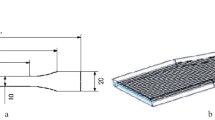Averaging the viscoelastic properties of rubber-cord composites is of interest from both theoretical and practical points of view. For example, the viscoelasticity of rubber leads to heat release in rolling tires, which affects their rolling resistance and the fuel-efficiency. This work focuses on two interrelated aspects: the experimental determination of viscoelastic parameters of the rubber and rubber-cord and their calculation using the averaging method. Since only rather small strains are considered, the linear viscoelasticity theory is used. Parameters of the generalized Maxwell model are obtained. It is revealed that the relaxation times used in the rubber-cord model can also be employed in the rubber model. It is shown that the averaging procedure allows one to obtain the relaxation function and to calculate the mechanical work under harmonic vibrations with a sufficient accuracy.







Similar content being viewed by others
References
S. V. Sheshenin, P. V. Chistyakov, M. E. Gritchenko, and I. M. Zakalyukina, “Averaging the viscoelastic properties of the rubber-cord layer,” Coll. of works of the 9th All-Russia. scientific. conf. “Mechanics of Composite Materials and Structures, Complex and Heterogeneous Media,” M., IPRIM RAN, 264-268 (2019).
A. A. Adamov, V. P. Matveenko, N. A. Trufanov, and I. N. Shardakov, Methods of Applied Viscoelasticity [in Russian], Yekaterinburg: Ural Branch of the Russian Academy of Sciences (2003).
A. S. Yankin, R. V. Bulbovich, S. V. Slovikov, and V. E. Vildeman, “Methodological issues of experimental studies on viscoelastic filled polymer composites under complex dynamic cyclic actions,” Vestn. PNRPU, Mekhanika, No. 4, 180-192 (2013).
M. Ly, K. A. Khan, and A. Muliana, “Modeling self-heating under cyclic loading in fiber-reinforced polymer composites,” J. Mater. Eng. Perform., 29 (2020). doi: https://doi.org/10.1007/s11665-020-04663-7
O. Larin, Y. Vyazovichenko, E. Barkanov, and M. Itskov, “Experimental investigation of viscoelastic characteristics of rubber-cord composites considering the process of their self-heating,” Strength Mater., 50, 841-851 (2018). - doi: https://doi.org/10.1007/s11223-019-00030-7
J. Schieppati, B. Schrittesser, A. Wondracek, St. Robin, A. Holzner, and G. Pinter, “Heat Build-Up of Rubbers During Cyclic Loading,” ECCMR, Nantes, France (2019).
K. Hadjov and V. Aleksandrova, “Cyclic loading of rubbers — amplitude spectrum and payne effect,” J. Chem. Technol. Metall., 52, 415-420 (2019).
R. Xiao, H. Sun, and W. Chen, “An equivalence between generalized Maxwell model and fractional Zener model,” Mech. Mater., 100 (2016). doi: https://doi.org/10.1016/j.mechmat.2016.06.016
I. Hodge, Classical Relaxation Phenomenology, 81-107 (2019). doi: 10.1007 / 978-3-030-02459-8
M. Ferrante and C. Capponi, “Comparison of viscoelastic models with a different number of parameters for transient simulations,” J. Hydroinformatics., 20, No. 1 (2017). - doi: https://doi.org/10.2166/hydro.2017.116
M. Baumgaertel and H. Winter, “Determination of discrete relaxation and retardation time spectra from dynamic mechanical data,” Rheol. Acta., 28, No. 6, 511-519 (1989).
L. Nasdala, M. Kaliske, A. Becker, and H. Rothert, “An efficient viscoelastic formulation for steady-state rolling structures,” Comput. Mech., 22, No. 5, 395-403 (1998).
A. E. Belkin and V. K. Semenov, “Theoretical and experimental analysis of the contact of a massive tire with a running drum,” Izv. RAN, Mekh. Tverd. Tela, No. 3, 71-82 (2016).
G. Bódai and T. Goda, “Parameter identification methods for generalized Maxwell models: Engineering approach for small-strain viscoelasticity,” Mater. Sci. Forum., 659, 379-384 (2010). doi: https://doi.org/10.4028/www.scientific.net/MSF.659.379
D. Jalocha, A. Constantinescu, and R. Nevière, “Revisiting the identification of Generalized Maxwell Models from experimental results,” Int. J. Solids Struct., 67 (2015). doi: https://doi.org/10.1016/j.ijsolstr.2015.04.018
C. Basagiannis and M. Williams, “Modified Generalized Maxwell Model for hysteresis behavior of elastomeric dampers,” J. Eng. Mech., 146, No. 8. (2020). doi: https://doi.org/10.1061/(ASCE)EM.1943-7889.0001801
I. Fatima, N. Shafi, and H. Anjum, “Viscoelastic properties of rubber material modeling,” ICAEM., 117-121 (2019). doi: https://doi.org/10.1109/ICAEM.2019.8853764
N. S. Bakhvalov and G. Panasenko, “Homogenization: Averaging processes in periodic media (mathematical problems in the mechanics of composite materials),” Recherche, 67 (1989).
O. González, J. Otero, A. Ramírez-Torres, R. Penta, and F. Lebon, “On the effective behavior of viscoelastic composites in three dimensions,” Int. J. Eng. Sci., 157 (2020). doi: https://doi.org/10.1016/j.ijengsci.2020.103377
M. Lévesque, M. Gilchrist, N. Bouleau, K. Derrien, and D. Baptiste, “Numerical inversion of the Laplace–Carson transform applied to homogenization of randomly reinforced linear viscoelastic media,” Comput. Mech., 40, No. 4, 771-789 (2007). doi: https://doi.org/10.1007/s00466-006-0138-6
M. Kaliske and H. Rothert, “Formulation and implementation of three-dimensional viscoelasticity at small and finite strains,” Comput. Mech., 19, No. 3, 228-239 (1997). doi: https://doi.org/10.1007/s004660050171
V. V. Vasiliev and E. Morozov, Advanced Mechanics of Composite Materials, 2nd ed. - Elsevier (2007). doi: https://doi.org/10.1016/B978-0-08-045372-9.X5000-3
Z. Chen, Y. Xie, Z. Wang, Q. Li, X. Wu, and S. Zhou, “A Comparison of fast Fourier transform-based homogenization method to asymptotic homogenization method,” Compos. Struct., 238 (2020).- doi: https://doi.org/10.1016/j.compstruct.2020.111979
R. Christensen, Theory of Viscoelasticity, An Introduction. - 2nd ed. - Acad. Press (1982).
V. M. Akhundov and V. P. Lunyov, “Calculation and experimental study of a two-way reinforced rubber-cord composite in tension,” Mech. Compos. Mater., 37, No. 2, 131-138 (2001). doi: https://doi.org/10.1023/A:1010669502769
R. M. V. Pidaparti, “Analysis of cord-rubber composite laminates under combined tension and torsion loading,” Composites: Part B., 28, No. 4, 433-438 (1997). doi: https://doi.org/10.1016/S1359-8368(96)00064-9
Author information
Authors and Affiliations
Corresponding author
Additional information
Translated from Mekhanika Kompozitnykh Materialov, Vol. 57, No. 4, pp. 673-688, July-August, 2021. Russian DOI: 10.22364/mkm.57.4.05.
Rights and permissions
About this article
Cite this article
Sheshenin, S.V., Gritchenko, M.E. & Chistyakov, P.V. Averging the Viscoelastic Properties of a Rubber-Cord Ply in a Plane Stress State. Mech Compos Mater 57, 469–480 (2021). https://doi.org/10.1007/s11029-021-09970-1
Received:
Published:
Issue Date:
DOI: https://doi.org/10.1007/s11029-021-09970-1




